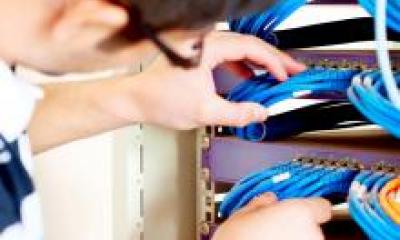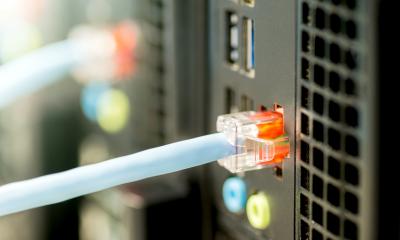
A network connects all the computers, tablets and smartphones in your office. You can share files, programs, and resources, including printers. A secure network is essential if you want to securely connect multiple devices.
To operate a network, you will have to invest in some dedicated equipment and get some specialist help to install and configure it.
1. Network basics
A network can connect all the digital devices within your business. Even if you only have two devices, investing in a network can still be worthwhile.
A network makes it easier to collaborate, communicate, share resources and maintain a high level of data protection
- It’s simple to share and collaborate on all types of files.
- Connected devices can use your network to access the internet and email.
- A network enables everyone to share a single printer.
- Antivirus software updates and security protocols can protect any connected device.
- Files can be stored, accessed, and modified (if users are granted access). You can limit access to files and folders if you need to.
- Secure networks enable employees to access company resources from outside the business.
- Your network can power your intranet.
You can build a network with or without a server
- A server is a central computer used to store files and run the network. It can either be located on-site or, more commonly, remotely in the cloud.
- A dedicated server provides a stable environment and can enable you to add valuable functionality.
- If you have a small number of devices (five or fewer), you probably won’t need a server.
- You may benefit from a server if you have more than five devices, or need to run centralised applications such as a customer database. However, many such applications are cloud-based solutions, which means you won't need an on-site server.
- Setting up and managing a physical server can be complex and expensive. Many modern businesses use cloud-based services that perform similar functions.
2. Network equipment
You may need to purchase a network server
Wi-Fi is commonly used for network connections, but you can also use cables to connect your devices together
- It's simpler and cheaper to create a wireless networks because there are fewer cables.
- The most common type of network cable is called an Ethernet cable. These cables are similar to telephone cables and have a plug on either end that looks a bit like a telephone connector.
- Ethernet cables are rated for speed. Most cables are either Cat7, Cat7 or Cat8.
- Cat8 cables and equipment deliver the fastest speeds.
- You can mix different categories of equipment on the same network although overall performance may suffer.
Every device you connect to the network must have a network adaptor
- Modern laptops, desktop computers, tablets and smartphones will have Wi-Fi connectivity.
- If you choose to run a hard-wired network, most desktop and laptop computers should have fixed ports to connect ethernet cables.
- If not, you can purchase adaptors for around £20.
You will also need a router
- A router sits at the centre of your network. It connects to the internet and provides both cable and Wi-Fi connectivity for devices.
- Routers can provide internet connectivity for multiple devices.
- The broadband package you have secured will have details on the maximum download speeds you can expect. The more devices you have connected to your network, the slower it will be.
- A router will manage the traffic on your network, provide internet access and ensure devices communicate effectively.
- If you are creating a hardwired network, ensure your router has enough connections (ports) for the devices you want to connect. If you have five computers and one printer, you will need at least six ports (unless any of those devices connect via Wi-Fi).
You may require a wireless access point (AP)
- An AP acts just like a hub and effectively extends the reach of your network for devices that connect via Wi-Fi.
- You can buy access points separately, or as part of a hub or router package.
- You may need several access points to provide wireless coverage throughout your premises.
A hardware firewall can protect your network from online security threats
- A firewall blocks malicious internet traffic and hackers.
- If you have a server, ensure there's a hardware firewall between it and your internet connection
- Most internet routers have firewalls built in. These provide adequate protection if you do not operate a server.
Wireless (Wi-Fi) networks
Many businesses, particularly small ones, favour the flexibility of Wi-Fi networks.
Wi-Fi networks replace network cables with a radio link
- Wireless networks aren’t as fast as wired networks, but speeds are increasing as technology develops.
- Modern Wi-Fi networks are more than adequate for day-to-day work.
- All new laptops, tablets and smartphones have wireless connectivity built in.
- Wi-Fi connections are simple to set up and you can add new devices by selecting the network from a list and entering a password.
- Multiple Wi-Fi networks can be configured to offer separate connections for guests, customers and staff. This enables businesses to retain full control over the available bandwidth and maintain network security.
If you're using Wi-Fi in your business, there are some issues to be aware of
- Wi-Fi networks have limited range. You may need to install several wireless access points to cover your business premises, especially if you have thick walls.
- Network interference can be a problem. It can be caused by other nearby Wi-Fi networks, electrical equipment and a host of other causes.
- You'll need to have strict security procedures, including access controls and encryption to prevent unauthorised connections. Look for hardware that supports WPA-2 encryption.
- The WPA-3 encryption standard is gaining popularity, but some devices may not recognise it.
Some businesses find a combination of wired and wireless technologies works best
- Fast, reliable access can be supplied to fixed desks via cables.
- A Wi-Fi network can be set up to cover meeting rooms and common areas. It is ideal for ad-hoc work, meetings and providing temporary internet access to visitors.
Win and keep customers
Track all customer enquiries and make sales simpler with CRM software. Find your perfect fit with these tools from our Donut partners.
3. Internet
Internet connections provide connectivity within your building but can also enable workers to access the network remotely.
To connect to the internet, you’ll need a broadband connection
- The cheapest type of broadband is called ADSL. It connects to the internet over an ordinary telephone line. ADSL packages cost from about £25 per month.
- If you have a basic network without a server, you can buy a router which connects directly to the internet using ADSL.
- The router also acts as the centre of your network. You need to connect all your devices to it to share the internet connection.
- Operating systems including Microsoft Windows, macOS, Android and iOS will automatically recognise the internet connection when you connect each device to the router via a cable or Wi-Fi.
An ADSL connection may not be adequate for every business
- Using ADSL, uploading is much slower than downloading. This means ADSL is not usually suitable if you regularly send large files.
- Although ADSL can provide speeds as fast as 100Mbps, many packages do not have guaranteed levels of service and offer poor contention ratios when shared with surrounding businesses or homeowners.
The benefits of fibre broadband
- Fibre connections are now available across most of the UK. They are significantly faster and more reliable than ADSL. For most businesses that require a stable, fast and reliable internet connection, fibre is usually worth the extra cost.
- If you have a large network or specialised requirements, talk to your internet service provider and your IT supplier to establish what type of connection best fits your needs.
- Depending on where your business is located, you may be able to access financial support to install it. Check online for available Government incentives.
4. Installing your network
Installing a network is disruptive and requires careful planning. It often pays to employ a specialist contractor or independent expert, especially if you are installing a server.
Installing cabling will cause the biggest disturbance and take the most time
- Install enough cabling and outlets to see you through any planned growth. Having spare outlets can enable you to add new devices easily, if required.
- Remember to install a cable that runs to your wireless access points. These are often located on the ceiling.
Install network hardware once the infrastructure is in place
- Connect the network server and one desktop computer to configure the system.
- Check all parts of the network server are working correctly.
- Install any other communications hardware you need throughout the building, such as routers.
Install the network software
- Configure the network operating system software using the test desktop computer.
- Install any network applications you may require on the main server.
- Run a full backup and check it carefully.
- Configure one of the desktop computers.
- Configure and run any network management software you use.
- Copy the desktop configuration to each device once you are confident the system is working.
- Establish access rights and passwords for individual users.
- Test wi-fi connections from several devices simultaneously.
5. Network security
Your data is valuable and vital to your business. It is critical that you keep this information secure.
Control access with usernames and passwords
- Each network needs their own username and password.
- Only give each employee access to the files, systems and programmes they need to perform their job.
Use security software on all your company computers and servers
- Good security software will protect against viruses, spyware, ransomware, hackers and other online dangers.
- Ensure you regularly update your virus protection software to keep yourself from new and emerging threats.
Use multiple firewalls
- A firewall will protect your devices from hackers trying to get access to your network or systems.
- You should ensure there's a firewall operating on every computer. Most operating systems have built-in firewalls. Ensure these are turned on.
- A single hardware firewall between your internet connection and network will provide additional protection.
Keep your server in a secure location and follow good IT security practice
6. Network management
Networks become more complicated as they grow. You need to have a realistic idea of the resources and support you will need to maintain your network.
A typical small network only demands at most a few hours' attention each week
- It should be possible for one person to manage a small network.
A medium-sized network requires more management
- For example, a network with a server and 10 to 100 devices needs at least one person working full-time to manage it.
- There may be more complex issues about who can access files and software that require specialist support.
Do not underestimate the resources required to keep your network running smoothly
- You may need two or more people to provide network support if a large network is central to your business.
- Seek advice from your IT supplier or a network consultant if necessary.
- Budget for network management and maintenance.
Signpost
- Find networking guidance from Cisco.
- Find guidance on cyber security from Get Safe Online.
Expert quote
"IT networks need to be intelligent and able to help your business to grow, not hinder it. Staff need always-on access to email and files whether they are in the office or working remotely and data needs to be backed up so it cannot get lost. IP networking represents a way to consolidate IT and telephony investments, realise costs savings through single suppliers, lower maintenance and call costs and most importantly enhance business by providing new features that help bring companies closer to their customers." - James Passingham, Foehn



